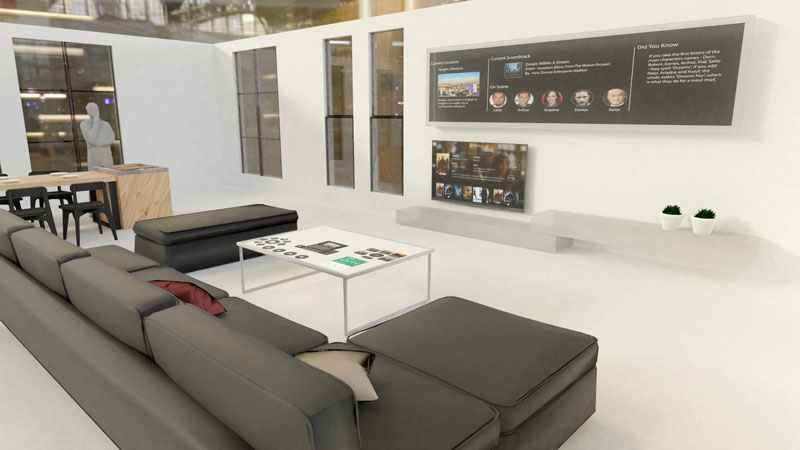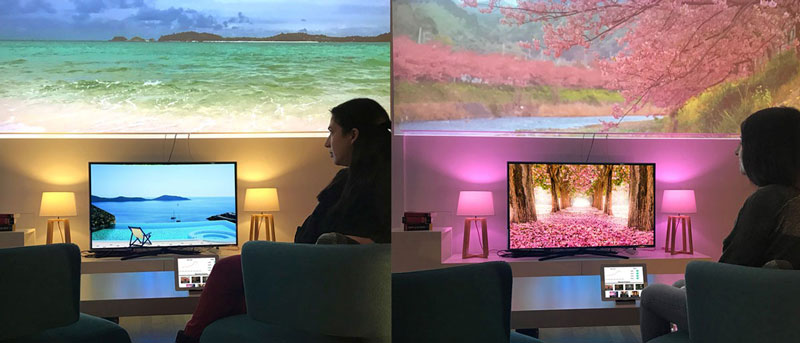by Constantine Stephanidis (FORTH-ICS)
The ICS-FORTH Ambient Intelligence (AmI) Programme is a long-term horizontal interdisciplinary RTD Programme aiming to develop pioneering human-centric intelligent technologies and environments which seamlessly support everyday human activities and enhance well-being through human-technology symbiosis.
ICS-FORTH has been investigating the potential of AmI technologies in domestic life [L1]. Inside the “Intelligent Home” simulation space located within its AmI Facility, everyday user activities are enhanced with the use of innovative interaction techniques, artificial intelligence, smart objects, ambient applications, sophisticated middleware, monitoring and decision-making mechanisms, and distributed micro-services. This tightly-coupled conglomeration of software and hardware components seamlessly interoperate so as to generate an ambient context-aware ecosystem that aims to: (i) improve the quality of life though appropriate monitoring of health-related variables (e.g. stress, sleep quality, nutrition); (ii) behave as an intelligent agent that communicates with the users in a natural manner and assists them in their daily activities; (iii) transform the environment into an ambient notification hub and personalised communication centre for the occupants (e.g. family members); (iv) implement a self-adaptive, energy-efficient and eco-friendly home control middleware; and (v) enhance leisure activities by providing entertainment experiences.
In particular, the hardware facilities of the Intelligent Home consist of: (i) an extensive grid of sensors and actuators that monitor and control various aspects (e.g. environmental conditions, energy and water consumption); (ii) smart commercial equipment (e.g. lights, speakers, locks, kitchen appliances, oil diffusers); (iii) smart devices and wearables (e.g. smart TVs, tablets, smartphones, smart watches, smart wristbands of various sorts); and (iv) technologically augmented custom-made artefacts. These components work in conjunction with the distributed computational framework of the Intelligent Home, named AmIHomeOS, so as to facilitate the realisation of comprehensive scenarios that accommodate various use cases (e.g. a family of four, an elderly couple, a disabled single adult) targeted to transform the domestic space into an all-inclusive environment that assists end users in an intelligent and personalised manner.

Figure 1: A photorealistic 3D rendering of the “Intelligent Livingroom”.
The living room of the Intelligent Home has been transformed into a smart space that exploits ambient technologies (i.e. intelligent artefacts, technologically-augmented furniture) and services (e.g. video on demand, user profiling), as depicted in Figure 1. In this context, AugmenTable (a smart coffee table acting as a touch-enabled projection area, while being aware of the objects placed on it) and SmartSofa (a sofa equipped with sensors that detect user presence and posture and permit the execution of actions via mid-air gestures) interoperate with AmITV (a host of various interactive applications such as movie player, news reader, music player, etc.) and SurroundWall (an interactive wall-based display) in order to provide an enhanced viewing experience by transforming the overall space around the TV. Alongside, CaLmi aims to reduce the inhabitants’ stress levels by real-time monitoring of various psychophysiological (e.g. electrodermal activity, heart rate) and contextual (e.g. workload, upcoming appointments, social life changes) variables and distributing into the environment appropriate relaxation programs that exploit the existing ambient facilities (Figure 2).

Figure 2: The CaLmi system in action.
The bedroom is generally considered as the room of the house in which people retreat to unwind, relax, get ready and sleep. The intelligent bedroom supports these activities with the Hypnos framework, which aims to improve the quality of sleep by providing sleep hygiene recommendations. This relies on various sensors integrated under the bed, and the inhabitants’ wearables to monitor their physical activity (e.g. movement, time in bed), physiological signals (e.g. respiration rate, heart rate, snoring) and various sleep-related parameters (e.g. time to fall asleep, time asleep, sleep cycles) while resting. Moreover, Smart Wardrobe (a custom-made closet equipped with various sensors and an embedded tablet) along with Smart Mirror (an interactive augmented reality system) aim to provide outfit recommendations based on contextual information (e.g. weather prediction, user’s daily schedule, user preferences, clothes availability), allow users to be immersed in a “virtual mirror” where they can try them, and help them get dressed (i.e. helping them find what they are looking for).
Finally, the Intelligent Kitchen aims to integrate ambient technologies to support the inhabitants during the entire cooking process, ranging from the management of the inventory and shopping list, meal selection and preparation, to cleaning-up. Currently, in the kitchen, smart appliances and custom artefacts (e.g. smart cupboards, smart food containers) are accompanied by the AmICounterTop and AmIBacksplash systems, which constitute regular work surfaces augmented with technology so as to be transformed into interactive devices (e.g. primary or secondary displays, kitchen scales), assist the above tasks by communicating task-specific information to the user (e.g. highlight the ingredients needed for the current recipe step, recommend recipes based on goods about to expire, suggest buying more milk when the last bottle is about to be used).
Link:
[L1] http://ami.ics.forth.gr
Please contact:
Constantine Stephanidis
FORTH-ICS, Greece
+30 2810 391741











